Adrian Collins's Blog, page 130
July 24, 2022
REVIEW: The Last Blade Priest by W.P Wiles
One of the latest publications from independent SFF house Angry Robot is The Last Blade Priest by Betty Trask Award winning author W.P. Wiles. The Last Blade Priest is Wiles’ fantasy debut. It is a brilliant epic multiple point of view novel with an original and inventive story that uses some of my favourite fantasy features exceptionally well. I think that The Last Blade Priest would be an excellent choice for fans of John Gwynne, R.S. Ford, or Daniel T. Jackson.
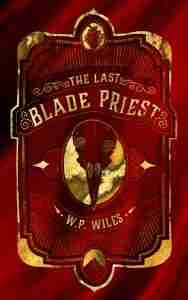 Unlike a lot of multiple point of view novels, Wiles only has three perspectives in The Last Blade Priest. However, the first third of the novel follows two of the trio. Firstly, there is Inar, a Master Builder with the extraordinary skill of ‘feeling’ stone. He is drafted to work for the League, a group who invaded and conquered his homeland. Then follows Anton, a pacifist mountain dwelling Blade Priest who is reluctantly part of a bloody religious order. This order has performed human sacrifice for generations to honour massive corvus demi-gods, so in the unlikely event that chapter one of The Last Blade Priest did not grab your attention, then chapter two most certainly will.
Unlike a lot of multiple point of view novels, Wiles only has three perspectives in The Last Blade Priest. However, the first third of the novel follows two of the trio. Firstly, there is Inar, a Master Builder with the extraordinary skill of ‘feeling’ stone. He is drafted to work for the League, a group who invaded and conquered his homeland. Then follows Anton, a pacifist mountain dwelling Blade Priest who is reluctantly part of a bloody religious order. This order has performed human sacrifice for generations to honour massive corvus demi-gods, so in the unlikely event that chapter one of The Last Blade Priest did not grab your attention, then chapter two most certainly will.
I was very impressed with the novel’s opening, but with the first hundred or so pages only switching between the narratives of Inar and Anton I did struggle with the pacing at the start. I love jumping straight into a story that grabs and runs away with you as a reader. However, a slower pace was actually essential here. Wiles’ world building is outstanding, but with the absence of any tools to assist a reader (such as the oft used map, glossary, or dramatis personae) all of this complex world must be conveyed through the narrative. There is a huge realm being introduced in The Last Blade Priest, with an intricate religious hierarchy, numerous factions, and an expansive geography. It is a testament to Wiles’ skill that this opening part of the novel is a successful slow burn that maintains the reader’s interest and does not overwhelm or confuse them.
Once the narrative perspective starts to follow Duna, a young woman whose magical skills hold terrifying possibilities, the pace of The Last Blade Priest significantly increases. When it does, the slow immersion in such a thoroughly established world is proven well worth the wait. Any plot predictions I had made were wrong, so Wiles’ writing ended up being superbly surprising at every twist and turn. I also really loved that the two main characters felt like relatively ‘normal’ people without world altering qualities or messiah-like roles to play. It gave the story a relatable humanity which can sometimes be missed in epic fantasy. Additionally the fact that The Last Blade Priest only follows a few points of view meant that tertiary characters were also well developed and all felt essential to the story. I am hoping that this may mean that some of these minor characters have a bigger role to play in later novels.
The Last Blade Priest is billed as ‘Book One of The Holy Mountain’ and Wiles has created a brilliant foundation for what I can only hope is the first in a series of novels. This has turned out to be one of my favourite new releases of this year, and I am incredibly excited to read what happens next. I am very grateful to both Angry Robot and W.P. Wiles for sending me an advanced reader copy to provide are view for Grimdark Magazine. 4.5/5.
Read The Last Blade Priest by W.P WilesThe post REVIEW: The Last Blade Priest by W.P Wiles appeared first on Grimdark Magazine.
July 23, 2022
REVIEW: A Storm of Swords by George R.R Martin
The strong momentum from A Clash of Kings continues in A Storm of Swords, the third volume of A Song of Ice and Fire, as George R.R. Martin chronicles his epic War of the Roses-style competition for the Iron Throne and control of Westeros. Although many important events occur on the battlefield, the more consequential tactics involve the forging and breaking of interfamilial alliances through strategic marriages and a healthy dose of backstabbing.
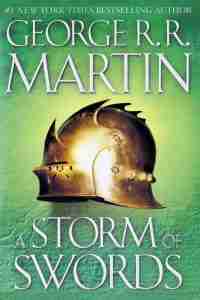 After spending most of A Clash of Kings imprisoned by the Starks at Riverrun, Jaime Lannister becomes one of the main point-of-view characters in A Storm of Swords. George R.R. Martin has accomplished a nearly impossible feat with Jaime, making the reader feel sympathy for this obnoxious, arrogant, incestuous Kingslayer. Despite all the terrible things he has done, Jaime still has a shred of honor, and I actually felt compassion for him by the end of the book.
After spending most of A Clash of Kings imprisoned by the Starks at Riverrun, Jaime Lannister becomes one of the main point-of-view characters in A Storm of Swords. George R.R. Martin has accomplished a nearly impossible feat with Jaime, making the reader feel sympathy for this obnoxious, arrogant, incestuous Kingslayer. Despite all the terrible things he has done, Jaime still has a shred of honor, and I actually felt compassion for him by the end of the book.
Another highlight from Jaime’s chapters is getting to know Brienne of Tarth, an imposing warrior who has sworn to deliver Jaime safely to the Lannisters in exchange for release of the Stark girls. I especially enjoyed seeing how Brienne manages her distaste for Jaime while fulfilling her promise to the Stark family. As Jaime’s situation becomes increasingly out of hand, Brienne’s strong commitment to his safety never falters.
Tyrion Lannister remains as one of the most intriguing characters in A Storm of Swords. Tyrion’s fraught relationship with his family is brought to the forefront, especially with his siblings, Cersei and Jaime, and his nephew, the insufferable boy-king Joffrey. The relationship between Tyrion and his father, Lord Tywin Lannister, is particularly tragic.
Among the Stark children, Sansa is essentially a Disney princess caught in a grimdark world. Originally hoping for a happily-ever-after with the pouty-lipped Joffrey, Sansa’s delicate innocence only brings her suffering. In A Storm of Swords, Sansa finally escapes the clutches of the Lannisters but is left to deal with the creepy Littlefinger, who harbors a lifelong infatuation with her mother, Catelyn. It’s hard to tell which situation is worse for the unfortunate Sansa.
Sansa’s younger sister, Arya, is the most Dickensian figure in A Song of Ice and Fire, orphaned and destitute, trying to survive in a cruel world that never does her any favors. Arya’s only glimmer of hope in A Storm of Swords—her arrival at a family wedding—proves to be an ill-timed disaster.
Love and violence are inexorably linked at Westeros weddings, especially in A Storm of Swords which includes the infamous Red Wedding massacre. We lose several major characters during nuptial festivities, although one of them has trouble staying dead.
Meanwhile up north, Jon Snow struggles between honoring his Night Watch vows and acting on his love for Ygritte. Unbeknownst to Jon, Bran Stark is also traveling north to the Wall in search of the three-eyed crow from his dreams. George R.R. Martin also introduces a third point-of-view character at the Wall, Samwell Tarly, the loyal friend of Jon Snow who serves as the Samwise Gamgee of the book. I found Sam’s perspective to be unnecessary given the other already-established point-of-view characters.
I also question George R.R. Martin’s decision to go all-in with Davos Seaworth, Stannis Baratheon’s favorite onion-obsessed confidant. There are many layers to the Onion Knight, but none of them are particularly interesting. The Davos chapters serve as a window into the matters of Stannis and the red priestess Melisandre. With her powerful magic and shadowy intentions, Melisandre would have been the more interesting choice to become the point-of-view character for these chapters.
Fortunately, we get to spend more quality time with Daenerys Targaryen in A Storm of Swords compared to A Clash of Kings. The exiled Mother of Dragons continues to amass power as she overcomes treachery within her own ranks. Daenerys becomes a favorite with everyday people as she frees enslaved populations en masse and exacts justice for crimes committed against them.
A Storm of Swords is a delight for grimdark fans and another high point in George R.R. Martin’s enduring saga of war and betrayal.
4.5/5
Read A Storm of Swords by George R.R MartinThe post REVIEW: A Storm of Swords by George R.R Martin appeared first on Grimdark Magazine.
July 22, 2022
The Dungeons & Dragons: Honor Among Thieves trailer is out!
Twenty-two years feels like a lifetime ago. I was nearly a whole other person; not as hardened or calloused to the world and its offerings. Not as jaded, certainly. I was an eager teenager with big bright eyes and on one weekend in particular I bought a ticket, a grossly over-priced and over-sized bucket of soda and tub of popcorn, and shoved myself into a seat to watch the much anticipated Dungeons & Dragons movie. What a time to be alive and a geek in the world. I’d spent most my young life consuming fantasy novels and game supplements, having adventures in imaginary lands with my friends, and none of us could believe they’d finally gone and made an actual movie seemingly just for us.
Fast forward roughly one hour and forty-seven minutes later and I left the theater … a little perplexed over what I’d just experienced. Flash forward roughly another twenty-two years and the world has seemingly, blissfully chosen to forget the existence of what would only be remembered as something of a box office flub at best and an absolute failure at worst (3.6 on IMDB says a lot). Which means it would come as no surprise when it was announced by the cinematic powers that be another big screen, blockbuster adaptation of the world’s most beloved role-playing game franchise was being adapted again there was a bit of a reaction. People were forced to dredge up memories of purple melodrama and unfunny comedic bits. Weird ear monsters and less savory moments. The most vocal of the crowd were flat out against it, of course. The fandom has grown emboldened and empowered over recent years thanks to a surge in popularity and acceptance of the past-time once relegated to nerds, losers, and weirdos in their parent’s garages and basements. We have a voice now and we will be heard, dammit.
The powers that be must’ve listened. Must have taken the fandom seriously. Maybe some of the folks making the new movie were some of the same kids who, just like me, walked out of that theater twenty years ago wondering what the hell just happened. Maybe, just maybe, they thought they could do better. They had to do better.
If the recently released trailer for Dungeons & Dragons: Honor Among Thieves is anything to go by, we’ve got something really special to look forward to. A trailer is made—edited and weaponized—to serve a singular purpose: distill something down to its absolute essence and raise interest, and the trailer I watched did that and then some. It got me excited. It made me genuinely happy. Sure, yeah, some of that was a brilliantly applied bit of Led Zepplin scored over all the action but a lot of it was just the tone and the portrayal of the action and the characters themselves. The movie just looks fantastic, top notch, like it takes place in a thriving and detailed world. The characters look fascinating and interesting and fleshed out and genuinely serve up some funny moments just in the couple minutes of the trailer’s length. More than anything else, what the trailer for Dungeons & Dragons: Honor Among Thieves does accomplish?
It looks fun.
It looks like an adventure I want to go on. And that’s exactly what a movie is supposed to be. That’s what a night around the table with your friends, rolling dice, laughing and hollering until the sun comes up is supposed to be.
It’s supposed to be fun.
Straight out the gate the trailer for Dungeons & Dragons: Honor Among Thieves sets the tone with a dragon. A freaking dragon. And, I don’t know, unless I’m mistaken it looks like a black dragon and that is just rad as hell and makes my geek heart soar. Then, sure, cue up Whole Lotta Love and the party’s rocking. If the trailer alone is so damn cool, it sets a heavy precedent for the rest of the movie. One I hope it definitely capitalizes on, especially with the party of adventurers—like the super cool Druid that goes full owlbear and hulks out on some unsuspecting knights. Major points. It’s like a highlight reel of awesome moments you’ve always wanted to see come to life from your own game sessions.
So, yeah. I’m hopeful. I’m optimistic and excited and will without question be buying a ticket and checking out Dungeons & Dragons: Honor Among Thieves on opening weekend. I’ll probably be blowing the dust off some old, beloved books I haven’t spent any time with in too long and diving back into a world I’ve stayed away from for a lot of years as well. I feel a bit inspired. It’s an exciting time to be a geek, and the new trailer has given us something I think truly worth being well and excited about.
The post The Dungeons & Dragons: Honor Among Thieves trailer is out! appeared first on Grimdark Magazine.
July 21, 2022
REVIEW: Kingshold by D.P. Woolliscroft
The novel Kingshold by self-published author D.P Woolliscroft is the first offering of the Wildfire Cycle series. If I could describe Kingshold in a few lines, it would be a beautiful but complicated tapestry. It is written in the vein of dark and intricate fantasy, much like the Malazan series or The Darkness That Comes Before. There are magic and fantasy aspects in Kingshold, but they come second to the political and societal maneuvers of the characters. Because of the breadth and scope of the worldbuilding, the first 200 pages of the story are on the slow side. I don’t fault the author for this. He had a lot of history and territory to lay out for the reader. Subsequently, I would think later books in the series Tales of Kinghold and Ioth, City of Lights, require much less narrative exposition and worldbuilding to get going. If you stick with the story and let Woollenscroft build a foundation for the politics and intrigue to sit in, you are rewarded with a well-crafted and entertaining political fantasy story.
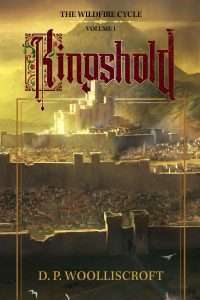 Kingshold is a place that has been riotously turned on its head. The king and queen of the city have been murdered, their heads set upon pikes. The governing body is in chaos. It is a vacuum that wants to be filled by the vainglorious and social climbers. Jyuth, the ancient wizard that had guided the court for centuries, is guilty of regicide. Tired of bad kings and queens, he sets out the rules for a new election.
Kingshold is a place that has been riotously turned on its head. The king and queen of the city have been murdered, their heads set upon pikes. The governing body is in chaos. It is a vacuum that wants to be filled by the vainglorious and social climbers. Jyuth, the ancient wizard that had guided the court for centuries, is guilty of regicide. Tired of bad kings and queens, he sets out the rules for a new election.
The people will vote on a new leader.
Anyone can vote as long as you can put in the 1000 coins to earn a spot at the voting table. This causes the disenfranchisement of many would-be voters; only the rich and elite get a say. And with that thought, the race to the crown proceeds. There is death, back-stabbing, pay-offs, propaganda, and riots. Everything you would come to expect in a situation like that.
Kingshold is entirely character-driven once the settings are set for the story. Most of it revolves around Mareth, the bard. Mareth is a man with stars in his eyes and the intelligence to help shape the future of Kingshold. Jyuth is the great wizard who started this tumultuous election in the first place. Both of these characters’ machinations shape the kingdom’s future.
Another one of the real strengths of Kingshold is the humor. This isn’t a powerful laugh-out-loud type story. But Woolliscroft does a great job in injecting a bit of lightheartedness into conversations that lift the dialog and keeps the pacing from getting stodgy. I appreciated that as a reader, and it was an excellent counterpoint to the dark political intrigue and backstabbing.
The engaging and detailed political plots, along with the humor and gorgeous worldbuilding, made this a treat to read. I look forward to tackling the next book in the series.
Read Kingshold by D.P. WoolliscroftThe post REVIEW: Kingshold by D.P. Woolliscroft appeared first on Grimdark Magazine.
July 20, 2022
REVIEW: The Trials of Ashmount by John Palladino
The Trials of Ashmount is the debut grimdark fantasy from John Palladino and the first volume in his Tragedy of Cedain series. In creating this complex world, brimming with nefarious characters, political backstabbing, and personal deceit, the author proves himself to be a promising new voice in grimdark fiction.
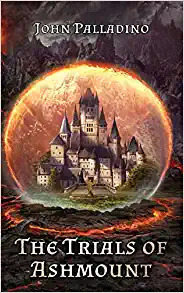 Palladino’s worldbuilding is ambitious in scope and accomplished in execution. Cedain encompasses three continents with five different countries. The author pays keen attention to each land’s unique politics, economy, and culture, as driven by their varying geography and religion. The worldbuilding in The Trials of Ashmount occurs naturally through the various point-of-view characters hailing from each of those lands. None of the exposition feels forced and, with one exception, the author mercifully spares us any extended info dumps.
Palladino’s worldbuilding is ambitious in scope and accomplished in execution. Cedain encompasses three continents with five different countries. The author pays keen attention to each land’s unique politics, economy, and culture, as driven by their varying geography and religion. The worldbuilding in The Trials of Ashmount occurs naturally through the various point-of-view characters hailing from each of those lands. None of the exposition feels forced and, with one exception, the author mercifully spares us any extended info dumps.
The Trials of Ashmount introduces a hard magic system with five branches: Enforcer, Glyphist, Collector, Healer, and Examiner. An intriguing aspect of Palladino’s magic system is the interdependence of these five branches. The practitioners of magic, the so-called Magicai, are centered at the University of Arcanical Arts, located adjacent to the great Ashmount volcano. New prospective Magicai must pass the Trials of Ashmount to receive formal training. Despite the nominally hard magic system, there is a soft element as well, predominantly coming from the Camel Clans of Vessia, who appear to have discovered a new form of magic outside the known branches at the University.
The Trials of Ashmount is primarily told from five point-of-view characters spanning the full world of Cedain. My favorite character is Demri Slarn, a sadistic rogue Magicus fixated on revenge against a former classmate and one of the most gleefully grimdark characters of the book. Demri is the Sand dan Glokta of the novel. Like Joe Abercrombie’s infamous character from The Blade Itself, Demri suffered grave injuries earlier in life and now lives in constant physical and emotional pain. Demri initially appears to be entirely villainous, but as we learn more about his background and motivation for revenge, he becomes a complex and even sympathetic figure.
My second favorite character is Kelden Stoole, the son of a baker who believes he is destined to escape his small-town life and become a powerful Magicus at the University of Arcanical Arts. Kelden travels to the University and dutifully follows their archaic and seemingly arbitrary rules to earn admission. His natural curiosity leads Kelden to discover some of the Magicai’s carefully guarded secrets.
Edelbrock Brendis is a fascinating point-of-view character, a minor nobleman who tries to scheme his way to greater fortune through a combination of lies, adultery, and murder. But the tables are turned on him rather quickly as he discovers a greater scheme at play. Although Edelbrock spends most of the novel as a rather shallow, pathetic figure, near the end he is given a fair amount of depth that helps earn sympathy.
I didn’t connect quite as well with the remaining two point-of-view characters. Sera Wintlock is an ordinary girl from the northern bird-farming continent of Cyrok who finds herself as an unlikely hero when her village is slaughtered during a surprise attack from the south. Sera suffers a lot during her plotline, but I don’t feel like the emotional trauma was fully conveyed. Finally, Villic is a nomadic warrior from the Camel Clans who hopes to leverage newfound magic to empower his people. Unfortunately, I never really connected with Villic as a character.
One of the joys of reading The Trials of Ashmount is seeing how the diverse storylines eventually intersect. This requires patience, since the connections don’t become apparent until the second half of the novel.
The plot is fast-paced and carefully constructed, full of unexpected twists, some of which left my mouth agape. My only criticism regarding the plot is that some of the major decisions occur too abruptly (for example, the discussions leading to war).
Palladino’s writing is straightforward and unadorned, with just the right level of snark to keep readers laughing but without becoming a parody of itself. Palladino has done an admirable job finding a balance between serious storytelling and irreverent commentary. Still, I was hoping that the prose could reach greater heights of eloquence, which would have helped deepen the emotional impact of many scenes and strengthen the reader’s personal connection to the characters. The characters suffer a multitude of tragedies throughout The Trials of Ashmount, and I feel that the impact of these situations could have had greater impact by slowing down and offering some more nuanced prose.
John Palladino shows great promise with his debut novel, which is also an entrant in Mark Lawrence’s 8th Self-Published Fantasy Blog-Off (SPFBO8). Overall, Palladino has created a compelling grimdark world that has a lot of potential for future entries in his series. With a bit more attention to developing the emotional depth of the characters, Palladino will be able to bring his craft to new heights.
3.5/5
Read The Trials of Ashmount by John PalladinoThe post REVIEW: The Trials of Ashmount by John Palladino appeared first on Grimdark Magazine.
July 19, 2022
REVIEW: Harrow Lake by Kat Ellis
Harrow Lake by Kat Ellis is not at all what you think. Marketed as a YA Horror novel, you would think that maybe this might be a campy horror story. Perhaps with a 1980s vibe.
You would be entirely wrong.
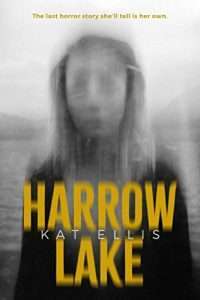 Instead, Harrow lake is a story of intense psychological horror. I think in a lot of ways, psychological horror is much scarier than slasher horror. The reader can eternalize much of the plot; we readers all have psychological quirks. Harrow Lake is a good book for that. The lead character, Lola, has broken parts of her psyche. She has suffered her mother abandoning her, a father who smothers her, and deep mental wounds that sound much like PTSD. This leads to a realistic characterization of mental illness and a developing and strong protagonist.
Instead, Harrow lake is a story of intense psychological horror. I think in a lot of ways, psychological horror is much scarier than slasher horror. The reader can eternalize much of the plot; we readers all have psychological quirks. Harrow Lake is a good book for that. The lead character, Lola, has broken parts of her psyche. She has suffered her mother abandoning her, a father who smothers her, and deep mental wounds that sound much like PTSD. This leads to a realistic characterization of mental illness and a developing and strong protagonist.
Lola Nox is the daughter of the famous Horror movie directer Nolan Nox. Nolan made his fame with the movie Nightjar, and he also met Lola’s mother on the set of Nightjar because it was filmed in her hometown, and she ended up being her star. Nightjar has an almost cult-like following to it. After an accident with Lola’s father, Lola ends up staying with her estranged grandmother in Harrow Lake while Nolan recuperates. Harrow Lake is dark, and something is off with it. Something is not right. The reader can not tell if the town is off or Lola’s perceptions of things are off. As Lola navigates the village of Harrow Lake and her traumatic memories, things escalate in the story to a fevered pitch.
What is real? What is imagined? The reader won’t know till the very end, and I can’t tell you more because of SPOILERS!
Harrow Lake ended up being one of those books that I appreciate as a reader but has aspects of it that didn’t sit well with me. In a lot of ways, Harrow Lake is perfectly crafted. The narrative moves from page to page, the horror is almost palpable, and the lead character is one that the reader can empathize with. However, I had a difficult time with the supporting characters in the story. I did not find them wholly believable. That was hard for me because the supporting characters are a huge part of the narrative. In the scheme of things, it is a small thing set against the excellent writing and Lola as a character, but it was a bit hard for me to get over it.
All in all, this is a solid and exciting story. It is terrifying and so much more than you thought it was going to be. The visuals that the author Kat Ellis creates are gripping, and the pacing is frenetic.
This story is a must for YA Horror fans.
Read Harrow Lake by Kat EllisThe post REVIEW: Harrow Lake by Kat Ellis appeared first on Grimdark Magazine.
July 18, 2022
REVIEW: In A Garden Burning Gold by Rory Power
In A Garden Burning Gold is Rory Power’s adult debut. After a couple of young adult novels, she’s switched over to writing for a new audience, and a new genre. This is dark epic fantasy, of politics, betrayal and power. In short, a book extremely well suited for the Grimdark Magazine readership, even if it may not look it at first glance. Inspired by Mediterranean culture, this is set in a secondary world ruled by Stratagyozi, long-lived tyrants with magical powers. Rhea and Lexos are the two oldest children of one such man, forced into his bidding for all of their lives. Rhea is married off on the regular, then kills her partners for power. Lexos is his father’s second, sent out to negotiate on his behalf, and has power over tides.
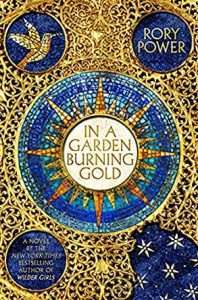 But they don’t operate in a vacuum. And they’re not content with their lot in life. And so this is a book about the game of thrones, about revolution, about shaping theworld into what you need it to be. It is not a happy story, and it is one in which much goes wrong – while there is a lot of very real betrayal inherent in the plot (and the concept), there is even more suspected betrayal, meaning that ultimately no character can trust the other’s motives. In many ways, this creates a world and a story in which you as the reader don’t know what will happen next as the plot unfolds. You are being kept on your toes throughout, and that is a brilliant feeling. In A Garden Burning Gold is one of those books where the puzzle of the story only gets put together slowly, where you don’t know what sort of picture you’re assembling, and that worked really well for me.
But they don’t operate in a vacuum. And they’re not content with their lot in life. And so this is a book about the game of thrones, about revolution, about shaping theworld into what you need it to be. It is not a happy story, and it is one in which much goes wrong – while there is a lot of very real betrayal inherent in the plot (and the concept), there is even more suspected betrayal, meaning that ultimately no character can trust the other’s motives. In many ways, this creates a world and a story in which you as the reader don’t know what will happen next as the plot unfolds. You are being kept on your toes throughout, and that is a brilliant feeling. In A Garden Burning Gold is one of those books where the puzzle of the story only gets put together slowly, where you don’t know what sort of picture you’re assembling, and that worked really well for me.
This is a standalone epic fantasy novel, which means that despite it being slightly longer than your average book at around 432 pages it doesn’t feel too long. As the story keeps twisting and turning, the pacing feels fast, and the tension is kept high throughout, making this a quick and entertaining read. It is not the most deep of books, but it feels like a book that you don’t encounter every day, especially given its setting in a Greek and Balkan inspired world, but not one inspired by Classic Mythology. I loved the complexities of the characters, especially Rhea and Lexos as the leads, though there were many more that were just as fleshed out with multifaceted personalities and motivations. This was a very solid four star read for me – and I’ve already reread it on audiobook!
Read In A Garden Burning Gold by Rory PowerThe post REVIEW: In A Garden Burning Gold by Rory Power appeared first on Grimdark Magazine.
July 17, 2022
REVIEW: Fearless by Allen Stroud
The search and rescue ship, the Khidr, is in distress. Of all her years in space, Captain Shann has never seen such a gruesome incident like this. Her crew is thrown into turmoil; one of their own is dead. While Captain Shann launches an investigation for suspected sabotage, a strange freighter signals for help. Fearless is a murder mystery without a grand detective. It is a maritime-esque adventure with improved tech and higher stakes. Fearless by Allen Stroud shatters the traditional essence of space opera.
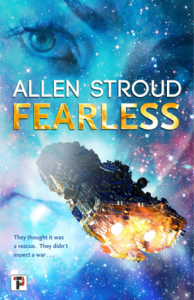 Fearless depicts a cumbersome time for humanity’s scientific advancements. The Moon, Mars, Ceres, and Europa have been colonized, but space travel remains costly and selective. Corporate greed and its interest, not science, furthers progress. Medical technology can engineer DNA matching limbs and organs but remains far from perfected. How flawed technology influences Allen Stroud’s characters is a significant element throughout his novel.
Fearless depicts a cumbersome time for humanity’s scientific advancements. The Moon, Mars, Ceres, and Europa have been colonized, but space travel remains costly and selective. Corporate greed and its interest, not science, furthers progress. Medical technology can engineer DNA matching limbs and organs but remains far from perfected. How flawed technology influences Allen Stroud’s characters is a significant element throughout his novel.
Fearless is a character-driven novel told through three perspectives, but primarily through Captain Shann. As we discover clues to the crew member’s death and the mysterious freighter, we are also given insight to these characters’ pasts. While Fearless is void of alien-species, the novel makes up for with inclusivity. Seven of the twenty-five member crew onboard Khidr use prosthetic limbs, including its captain. How Stroud wrote Captain Shann’s experience is the best highlight of this novel.
“Growing up, I was surrounded by a well-meaning family. They wanted the best they could imagine for me, but what they envisioned was a limited experience, trapped by walls and defined by my differences.”
Due to the emphasis on the events happening on Khidr and the intimate struggles of its crewmembers, Fearless has a claustrophobic quality. The intimate struggles of those onboard the Khidr shadows Earth’s political battles for a good portion of the novel. It makes certain key moments less impactful and some revelations too abrupt. For me, this novel isn’t a perfect blend of murder mystery and sci fi but I enjoyed the concept.
Allen Stroud gives grandiose ideas of space exploration a breath of realism. Space colonization may not be humanity’s salvation. For once, a sci fi novel didn’t invoke my sense of wonder for space. Stroud presents a somber view of our future; a spaceship flying to Europa is still chained to the problems on Earth. Yet, Stroud reimagines the appearance of a space captain and the qualities needed to travel across the stars. Fearless is a gamechanger for modern sci fi.
Read Fearless by Allen StroudThe post REVIEW: Fearless by Allen Stroud appeared first on Grimdark Magazine.
July 16, 2022
Grim Games from UK Games Expo 2022
Board and tabletop gaming has seen a rise in popularity over the past ten years or so, with more people coming into the hobby and greater numbers of projects finding their way to the table through crowdfunding sites like Kickstarter, Indiegogo or Gamefound. Tabletop gaming has a great breadth of styles, themes, mechanics, and genres to satisfy all sorts of tastes and experience levels. Every year there are conventions and expos across the globe attracting 1000s of visitors a day; one such event is the UK Games Expo, held in Birmingham, UK (pandemics permitting), over the first weekend after Whitsun (or the Late May Bank Holiday). I attended and kept my eye out for games on the darker end of the spectrum so that I could draw together five grim games to tempt you with, in no particular order.
Book of Skulls: Slayers of Eragoth
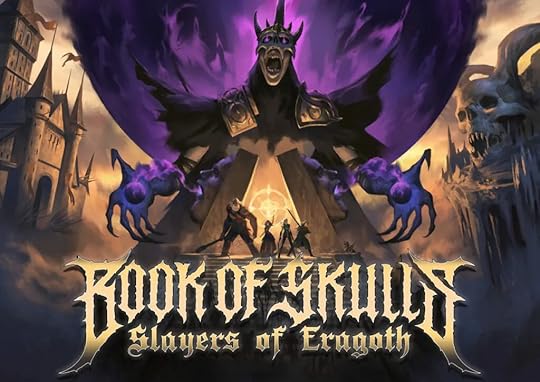
Described by our very own Matt Davis as “HeroQuest got all growed up and went metal”, Book of Skulls: Slayers of Eragoth is an ambitious dungeon crawler with its own soundtrack of, you guessed it, heavy metal. Soon to be looking for crowdfunding, this is a big game with lots to do and investigate. Besides the soundtrack, the game also features interesting mechanics, brilliant art, and one of the heroes is called Rei (OK, it’s spelled differently, but it’s pronounced the same: I can dream, can’t I?).
Each time your party fights the forces of evil the other player(s) are controlling the enemy and, when it’s their turn to slay through the hoards, it swaps, and you control the enemy forces. This is a nice little mechanic to minimise downtime between your turns. With 120 demons in the Book of Skulls and over 150 character cards, you’re going to see a lot of replayability over the 10 possible maps.
Book of Skulls: Slayers of Eragoth is currently in Prelaunch on Kickstarter and you can listen to some of the soundtrack already on their website: https://www.bookofskulls.co.uk/
Last Night on Earth
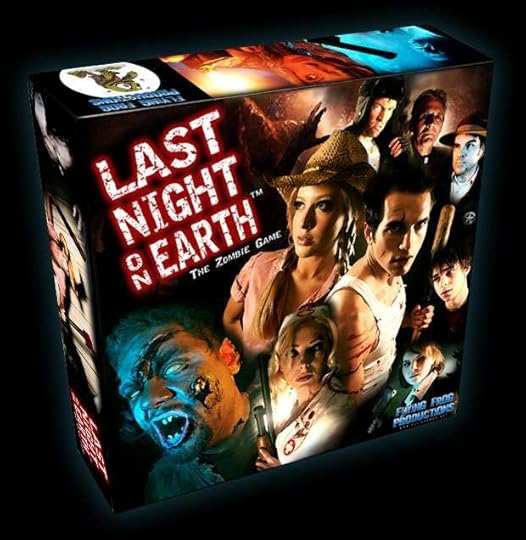
Coming from Ex Stasis Games, Last Night on Earth is an RPG “about making every moment count” as you live through your last night as a human. You are becoming a monster, literally, and you have unfinished business to attend to before you can no longer recognise yourself. It’s a tough balancing act as you try to settle your burden before its too late; if you push yourself, you embrace your monstrous nature and your time runs out faster, but if you don’t push it, you won’t lay your burden to rest.
Characters will die. Betrayal is part of the game. Violence and corruption are rife in a decaying world. This is a horror RPG in which you/your character is, put simply, “going to confront some shit”. These characters are living their last night and trying to make sure their lives had meaning. There’s not going to be some handily placed MacGuffin to stop the impending doom; no cures, or magic reverso spells, just the last few hours before you succumb to your curse.
Last Night on Earth is available digitally through itch.io and their website: https://exstasisgames.com/
Psychobabble
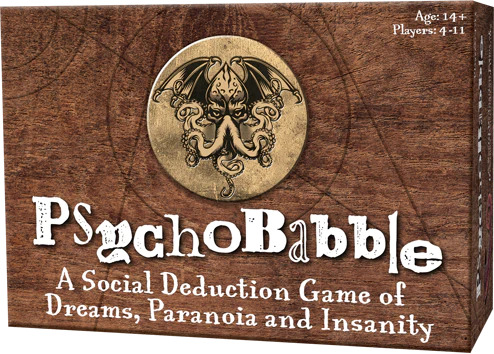
Psychobabble from Cheatwell Games presents itself as a card game – how grim could that be? If we look a little closer at the context though, it’s plenty dark enough. In Psychobabble, you are in an institution, you’re all having shared dreams, and the psychotherapist is analysing you closely to see who can be released as sane and who is being kept behind. The dream cards are laid out on a grid on the table, one ‘patient’ isn’t having the same dream as everyone else, the psychotherapist needs to figure out what the shared dream card is, whereas other patients need to figure out who is the odd one out.
It feels a little sinister and the images on the dream cards are all black and white and a bit nightmarish in their artwork. Lots of eyes, skulls, monsters, and tentacles. If you realise you’re the odd one out and are trying to convince the others you aren’t, you can’t lie (unfortunately), so you may be doomed back to more of this quack therapy in the creepy institution of shared dreamers.
More information at: https://cheatwell.com/products/psychobabble
Blackwell Games
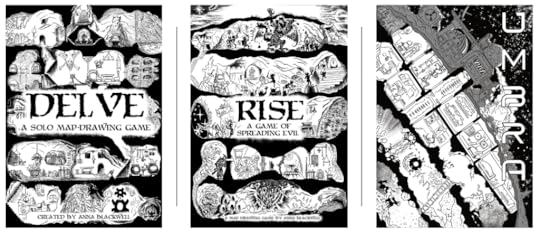
Blackwell Games is the creator of three solo RPG games that have deliciously dark vibes: Delve, Rise, and Umbra. In Delve, you are exploring your Dwarven hold and the underground world to find the Void Crystal, as you do you are as likely to encounter success as you are destruction. As you dig you can come across monsters, natural obstacles, and loot. There’s no guarantee you’ll find the crystal before your hold is destroyed by rampaging nightmares, gas-clouds and lava so proceed with caution.
Rise and Umbra are sister games of Delve. In Rise (the evil sister), you are spreading evil as you take charge of a dungeon and try to reach the surface and conquer those puny mortals. Providing your minions don’t mutiny along the way. Umbra, on the other hand, take a sci-fi setting and puts you in charge of a colony struggling against starvation, the void of space and the many terrors that surround you.
All available through itch.io and at Blackwell Games’ website: https://www.blackwellwriter.com/
Oathsworn: Into the Deepwood
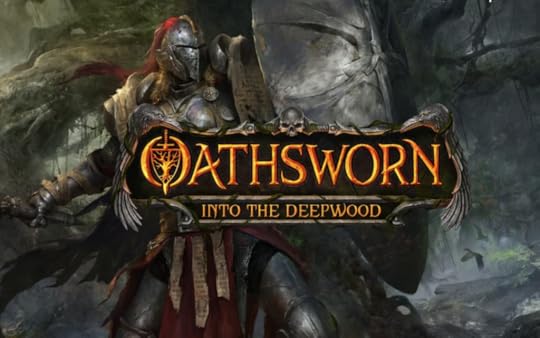
Oathsworn: Into the Deepwood is a dark fantasy RPG miniatures dungeon crawler that comes with a novel-length interactive book to guide you, which you can either read in hardback or utilise the audiobook function in the companion app. The setting finds humanity collapsed in the face of the Deepwood, a corruption that has long covered the land with a thick twisted forest. The King has pledged, “if you can hold it, you can keep it” but few have ever survived. Creatures of the Deepwood are constantly trying to breach humanity’s last defences and it is the Oathsworn who keep hope alive.
The game focusses on Encounters, like boss battles, that you – as Oathsworn – will work through the story towards as the only force brave enough to face the Deepwood’s hoards. Replete with miniatures up to 100mm large, Oathsworn is a big, chunky box, that is wrapping up all your favourite elements of epic fantasy, minis gaming and RPGs.
Already planning a second printing via Kickstarter, more information can be found on Shadowborne Games’ website: https://www.shadowborne-games.com/
The post Grim Games from UK Games Expo 2022 appeared first on Grimdark Magazine.
July 15, 2022
REVIEW: August Kitko and the Mechas from Space by Alex White
August Kitko and the Mechas from Space by Alex White is a kaleidoscope of a space opera story mixed with music notes and cinematic worldbuilding that takes the reader on a wild robot-fueled ride. If I had a visual comparison, think Speed Racer by the Wachowski sisters, mixed with Pacific Rim by Guillermo Del Toro. It is a whole vibe and one in which Alex White revels. You know he had to be cheering on the characters as he was writing this.
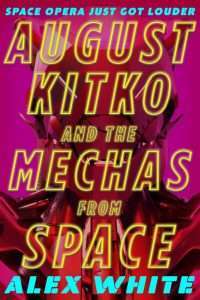 The plot starts with August Kitko staring at his demise on the cliff’s edge. August, Gus for short, is one of our protagonists, and he is a lover and player of jazz who truly feels music in his soul. But like his fellow humans, Gus has resigned himself to the fate of imminent death. He is at a party at the estate of Lord Elisa Yamazaki. The last party of humanity is a literal “eat, drink, and be merry for tomorrow we die” affair.
The plot starts with August Kitko staring at his demise on the cliff’s edge. August, Gus for short, is one of our protagonists, and he is a lover and player of jazz who truly feels music in his soul. But like his fellow humans, Gus has resigned himself to the fate of imminent death. He is at a party at the estate of Lord Elisa Yamazaki. The last party of humanity is a literal “eat, drink, and be merry for tomorrow we die” affair.
“These are Gods, and they speak with infinite choris.”
Humans are dying, not with a bang but with a single discordant note. An army of AI sentient Mechas from space are slowly destroying humanity by downloading each person’s consciousness and killing their bodies. Some of these killer robots break off, join the humans, and fight for humanity. The only caveat is that these robots need humans to pilot them, a prospect that would fundamentally change the human pilot forever.
Alongside Gus, we have our other protagonist Ardent Violet, a mega-pop star who shines with an inner light all their own. Again, in the same way music sings for Gus on his piano, music sings for Ardent on their guitar. Unlike Gus, Ardent is super famous. Both Gus and Ardent’s lives become intertwined. They have undeniable chemistry with one each other.
The Vanguard arrives on Earth in the form of a mecha named Juliette. A giant sleek purple robot set to start the maiming and destroying of bodies and reaping of consciousnesses. Then with an explosion of a “colorful Borealis of solar particles rippling across Earth’s atmosphere,” a sleek black Vanguard streaks across the sky. It is Greymalkin, the destroyer of seventeen worlds. The humans stare in stunned silence at the display of power, much like ants would stare in horror at an oncoming boot. The titans crash into each other in a thunderous cacophony. The Vanguards speak to each other in musical ululations, and above it all, Gus picks out F Dorian the favorite of jazz musicians everywhere.
Instead of gawking with the multitude of slack-jawed humans, Gus wants his true solace at the piano. “He taps the F-zero key, and it’s like heaven under his fingertips.” Gus lays in an effortless sound that “shifts modes to keep in sync with his new playmates,” the Vanguards crashing into each other outside. Gus dances over the sound of the robots outside as if they are playing for him. “If they want to end the world, fuck them. At least he can make it catchy.” Gus plays for the lost dead, his friends, his family, and the last vestiges of humanity.
Then ardent, whom he connected with earlier, come in like a ray of sunshine; they brandish a red metal flake strat. And they prepare to play to the end of humanity until a black metal fist punches the wall in and grabs Gus.
One of the particular thrills of August Kitko and the Mechas from Space is the love of music and art. The story itself ebbs and flows like a symphony. I am not sure if that was a purposeful stroke by the author or me reading into it from being swept away by the descriptions of music. But the descriptions speak to the universal connections music gives us that are not bound by language or creed. Outside of the main characters, Gus and Ardent, the supporting characters we meet later in the novel also have a deep love for music, but with different instruments. I love that White is touching on how music is culturally boundless.
If you have giant robots, we have to talk about the fights. Firstly, we get descriptions of every Vanguard that comes in swinging. The descriptions and names are fantastic because it is akin to cheering the home team on. You have a much greater connection to these giants than them being a nameless horde. Every punch and kick is choreographed to have the most effective mental image. The swings are enormous, the slams are massive, and machine parts fly. In the belly of the gigantic beasts are pilots controlling it all.
Why does this story work? I think in lesser hands, this story could be a mess. There are a lot of working pieces. However, White helps us keep our eye on the ball. We care about the protagonists, probably more so than the fate of humanity in general. Gus and Ardent are not perfect in any way. Ardent can be narcicistic, and Gus can be melodramatic. But both characters rise above through pain, terror, failure, and heroism. They reach inside themselves to be more than they ever thought possible. Someone has to step up and do it, so why not them?
Is this book for everyone? Absolutely not. As I said earlier, this book is a kaleidoscope—a crazy fast, moving, loud story with brilliant lights and massive highs and lows. It isn’t for someone who enjoys subtle prose. It is intense from the first page to the last. So if you enjoy stories like Nophek Gloss by Essa Hansen and Far From the Light of Heaven by Tade Thompson, this story is for you.
Read August Kitko and the Mechas from Space by Alex WhiteThe post REVIEW: August Kitko and the Mechas from Space by Alex White appeared first on Grimdark Magazine.



